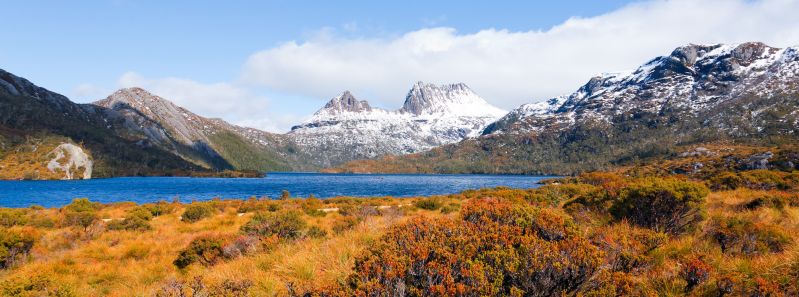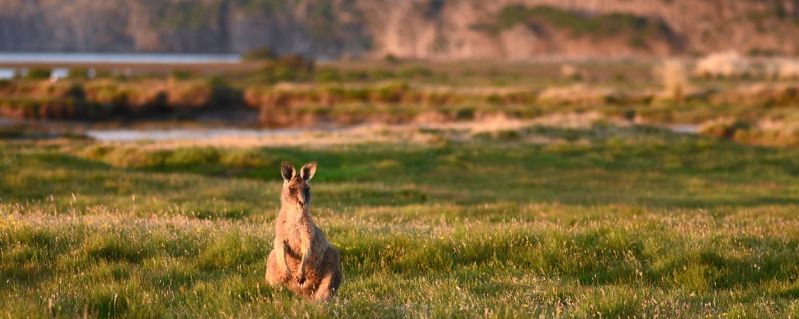Alpine & Subalpine
Over the last 700 million years, Tasmania has experienced a range of geological activity, with three periods of deformation and four periods of igneous activity. This has resulted in beautiful alpine landscapes, with many dominated by dolerite, which rose as a liquid and solidified about 150 million years ago in the earth’s crust.
The ice cap on the Central Plateau is responsible for eroding much of the Tasmanian highlands, including Lake St Clair, which was scoured out by glacial action over two million years and is the deepest freshwater lake in Australia with a maximum depth of 167 metres. There is a vast contrast in vegetation across concentrated areas, with distinct boundaries between Alpine Shrubby Heaths, Grasslands, Buttongrass Moorlands and Pineforests.
Amazingly, over 60% of all species found across the alpine region are found nowhere else on Earth. Wombats are a common sight throughout the sub-alpine regions, while Pademelons, Tasmanian Devils and Echidnas can also be seen. Green Rosellas, Black Currawongs, Pink Robins and Tasmanian Scrubwrens are some of the more typical bird species, whilst Peregrine Falcons and Wedge-tailed Eagles can be seen sporadically, nesting on the mountains cliffs.

Wetlands & Estuaries
Tasmania has a higher concentration of wetlands than any other Australian state, with the Tamar River Conservation Area, Narawntapu National Park and Moulting Lagoon Game Reserve some of most popular areas for wildlife enthusiasts. Waterfowl and seabirds such as Pied Oystercatchers, Pacific Black Ducks, Hooded Plovers, White-faced Herons, Australian Shelducks, Chestnut Teals, Australasian Shovellers, Black-faced and Little Pied Cormorants and Great Crested Grebes and migrants such as the Common Greenshank, rely on wetlands for feeding and many for breeding.
The fringes around the wetlands and estuaries, especially at Narawntapu are renowned for an incredible concentration of marsupials including Eastern Grey Kangaroos, Red-necked wallabies, Tasmanian Pademelons, Common Wombats and Eastern and Spotted-tail Quolls.

Rainforests & Eucalypt Forests
Tasmanian forests date back over 60 million years, when Australia was attached to Antarctica, Africa, South America and New Zealand as part of the Gondwana supercontinent and ancestral species can be found in some of these regions. Mammals that call the rainforests home include the Ringtail Possum, Pademelon, Spotted-tailed Quoll and Dusky Antechinus whilst 21 species of native birds are found including the Black Currawong, Green Rosella, Olive Whistler and Grey Goshawk.
Myrtle-beech is the dominant species across Tasmania’s rainforests growing up to 50m and aged up to 500 years old. Over half of the 29 eucalypt species found in Tasmania are endemic, with both wet and dry eucalypt forests prevalent. Wet eucalypt forests are found mostly in the south, west and northwest of the island. Tall eucalypts can grow to 90m here including the Swamp Gum, Stringybark and Gum-topped Stringybark tend to dominate these areas. Spotted-tail Quolls, Tasmanian Devils, Long-nosed Potoroos, Southern Brown Bandicoots, Scrubtits, and Yellow-tailed Black Cockatoos are commonly seen in this habitat.
Coasts
The Bay of Fires is one of Tasmania's most spectacular conservation reserves, renowned for its orange lichen-covered granite boulders and white sandy beaches, formed due of the high quartz content of the granites, which has eroded into a very pure white sand.
The Freycinet Peninsula, home to Wineglass Bay and the Hazards, is made up of a orthoclase-rich granite which gives the mountains and coastline a characteristic gorgeous pink tint, flanked by and native forest edged by crystal blue bays. Tasmania has the largest exposure of dolerite in the world and is subsequently referred to as the ‘rock that made Tasmania’, with the Tasman Peninsular and Bruny Island boasting some of the most spectacular cliffs in Australia.
There are many mammals found close to Tasmania’s coastline including Red-necked Wallabies, Echidnas, Wombats, Tasmanian Bettongs, Long-nosed Potoroos, Brushtail Possums. Many of Tasmania’s 261 bird species are found on the coasts, including White-bellied Sea Eagles, Australian Fairy Terns, Shy & Black-browed Albatross and Little Penguins.

